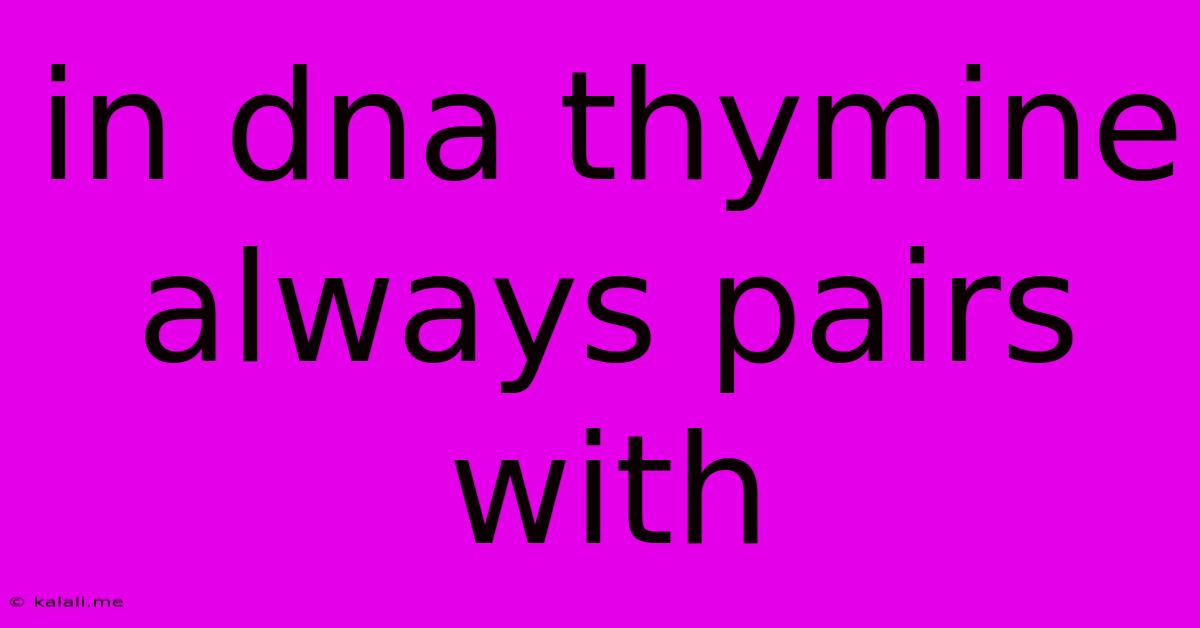In Dna Thymine Always Pairs With
Kalali
Jun 14, 2025 · 3 min read

Table of Contents
In DNA, Thymine Always Pairs with: Understanding Base Pairing
DNA, the blueprint of life, is a complex molecule responsible for storing and transmitting genetic information. Understanding its structure is crucial to comprehending how this information is passed down through generations and utilized by living organisms. A key aspect of this structure is the specific pairing of nitrogenous bases, and this article will explore the fundamental principle: in DNA, thymine always pairs with adenine.
This seemingly simple statement underpins a wealth of biological processes. Let's delve into the details of base pairing and its significance.
The Structure of DNA: A Double Helix
DNA's iconic double helix structure, discovered by Watson and Crick, is formed by two complementary strands twisted around each other. These strands are composed of nucleotides, each consisting of three parts:
- A deoxyribose sugar
- A phosphate group
- A nitrogenous base
It's these nitrogenous bases that dictate the genetic code and are responsible for the specific pairing we're discussing. There are four types of nitrogenous bases found in DNA:
- Adenine (A)
- Thymine (T)
- Guanine (G)
- Cytosine (C)
Chargaff's Rules and Base Pairing
The specific pairing of these bases isn't random. Erwin Chargaff's rules, established through his research on DNA composition, revealed a fundamental pattern: the amount of adenine in a DNA molecule always equals the amount of thymine, and the amount of guanine always equals the amount of cytosine. This observation directly led to the understanding of complementary base pairing.
This complementary pairing is dictated by hydrogen bonds, a type of weak chemical bond that forms between the bases. Adenine (A) forms two hydrogen bonds with thymine (T), while guanine (G) forms three hydrogen bonds with cytosine (C). This specific pairing is crucial for the stability and accurate replication of the DNA molecule. The precise number of hydrogen bonds also contributes to the overall strength and stability of the DNA double helix.
The Significance of A-T Base Pairing
The consistent pairing of adenine and thymine is fundamental to several key biological processes:
-
DNA Replication: During replication, the DNA molecule unwinds, and each strand serves as a template for the synthesis of a new complementary strand. The precise A-T and G-C pairing ensures accurate duplication of the genetic information. Any errors in base pairing can lead to mutations.
-
DNA Transcription: Transcription is the process of creating RNA from a DNA template. Again, the accurate base pairing is crucial for the faithful transfer of genetic information from DNA to RNA. This process is essential for protein synthesis.
-
Genetic Code: The sequence of bases along the DNA molecule determines the genetic code, which dictates the synthesis of proteins. The consistent A-T and G-C pairing ensures the integrity of this code.
-
DNA Repair Mechanisms: Cells have sophisticated mechanisms to repair DNA damage, including errors in base pairing. These repair pathways rely on the inherent complementarity of the bases to restore the original sequence.
In summary, the statement "in DNA, thymine always pairs with adenine" is not merely a fact but a cornerstone of molecular biology. This specific base pairing is essential for the structure, replication, transcription, and overall function of DNA, ultimately underpinning the continuity of life itself. Understanding this fundamental principle unlocks a deeper appreciation of the intricacies and elegance of the genetic code.
Latest Posts
Latest Posts
-
Which Of The Following Is Not A Data Type
Jun 15, 2025
-
Which Soil Particle Is The Smallest
Jun 15, 2025
-
What Is The Difference Between Detention And Arrest
Jun 15, 2025
-
Dynamic Viscosity Of Air At 20c
Jun 15, 2025
-
Which Of The Following Is Not A Common Tqm Tool
Jun 15, 2025
Related Post
Thank you for visiting our website which covers about In Dna Thymine Always Pairs With . We hope the information provided has been useful to you. Feel free to contact us if you have any questions or need further assistance. See you next time and don't miss to bookmark.